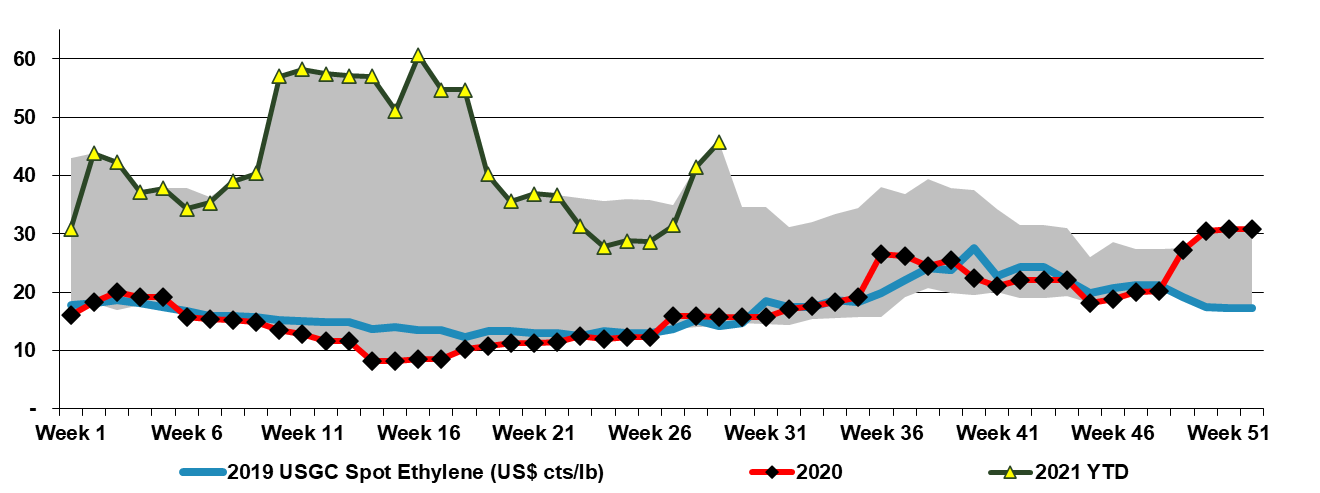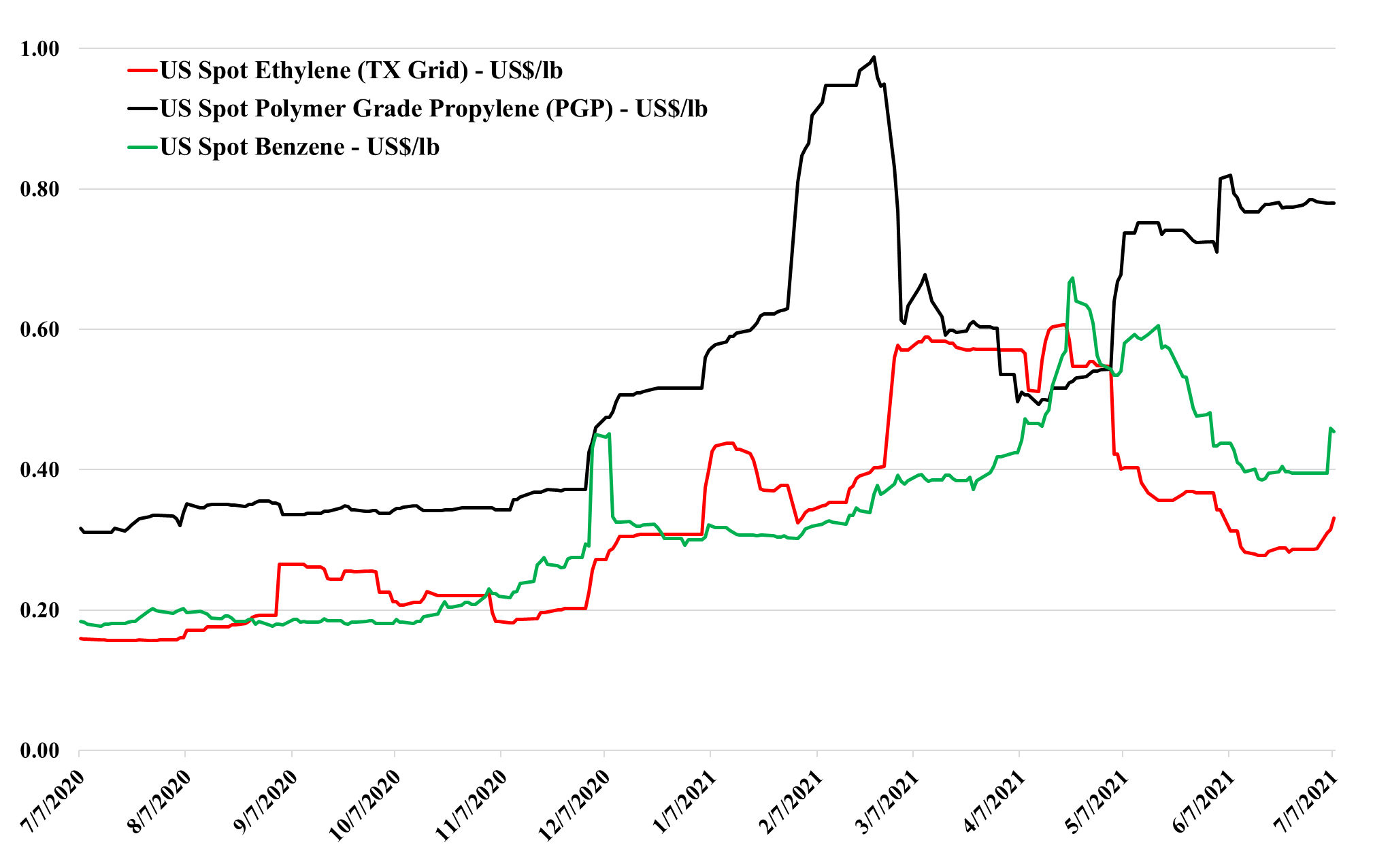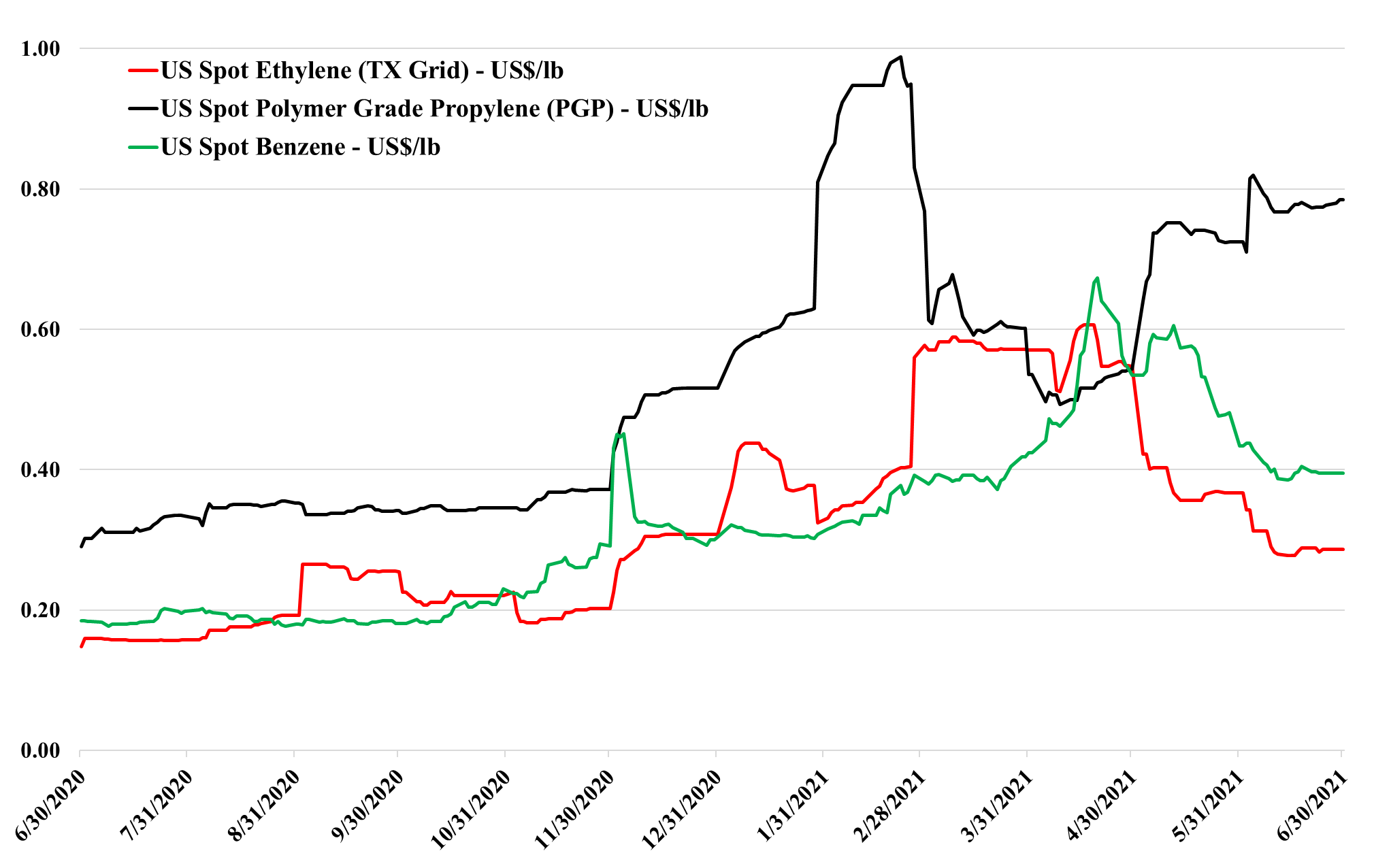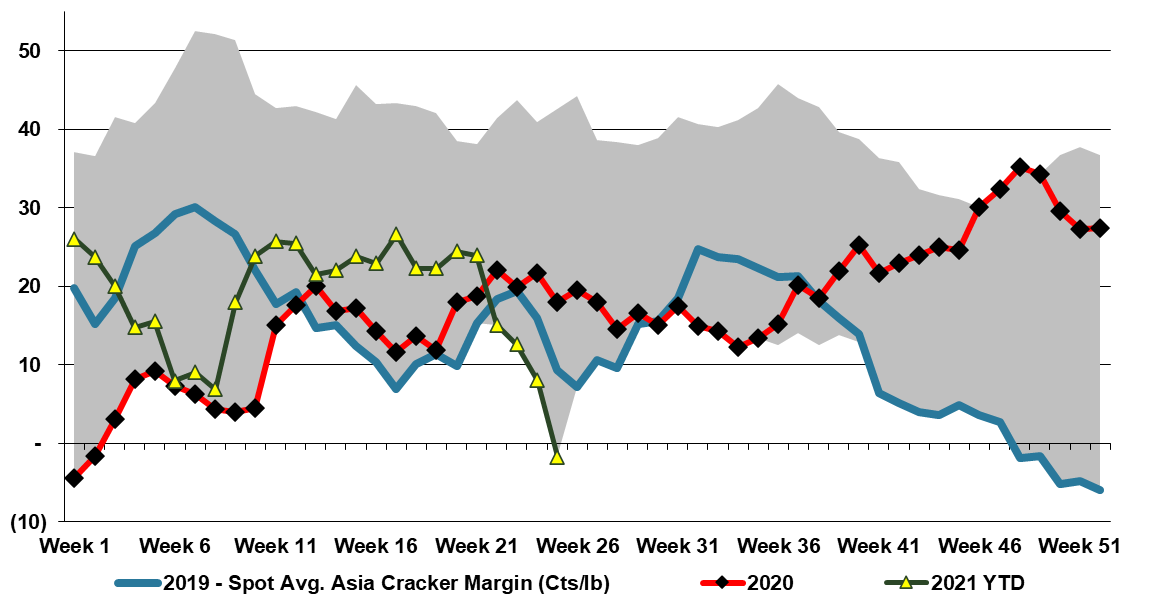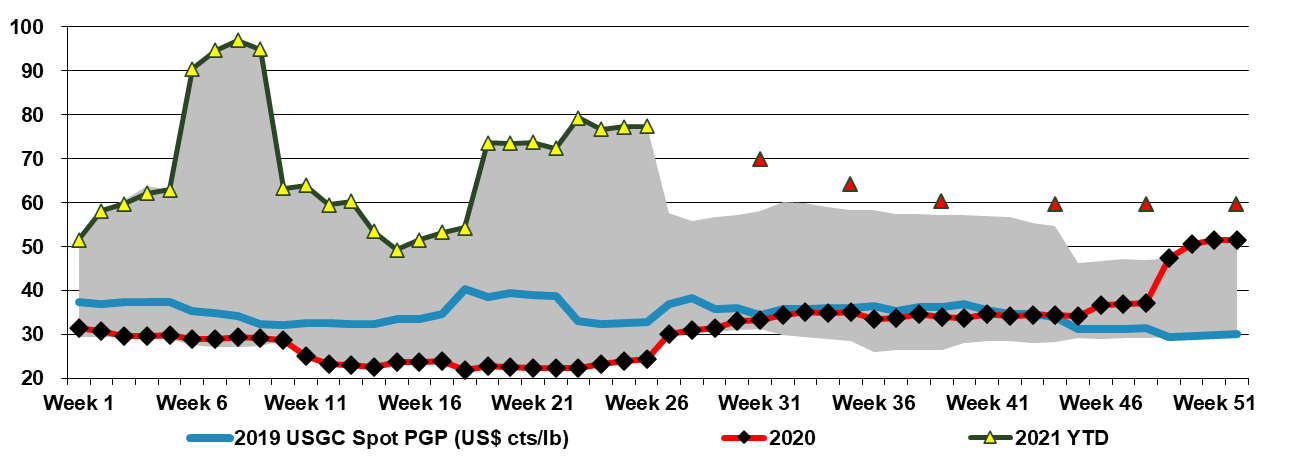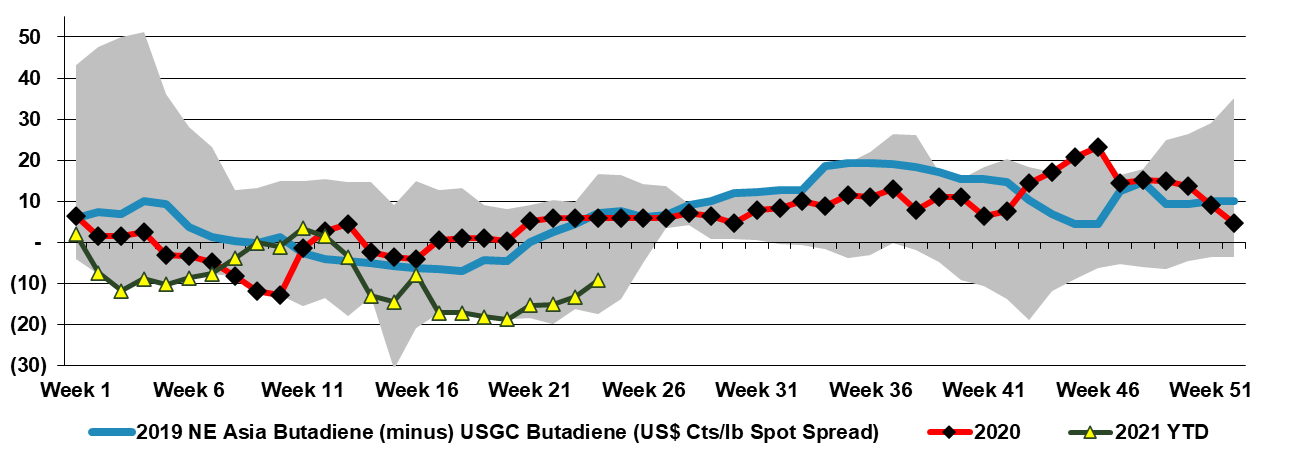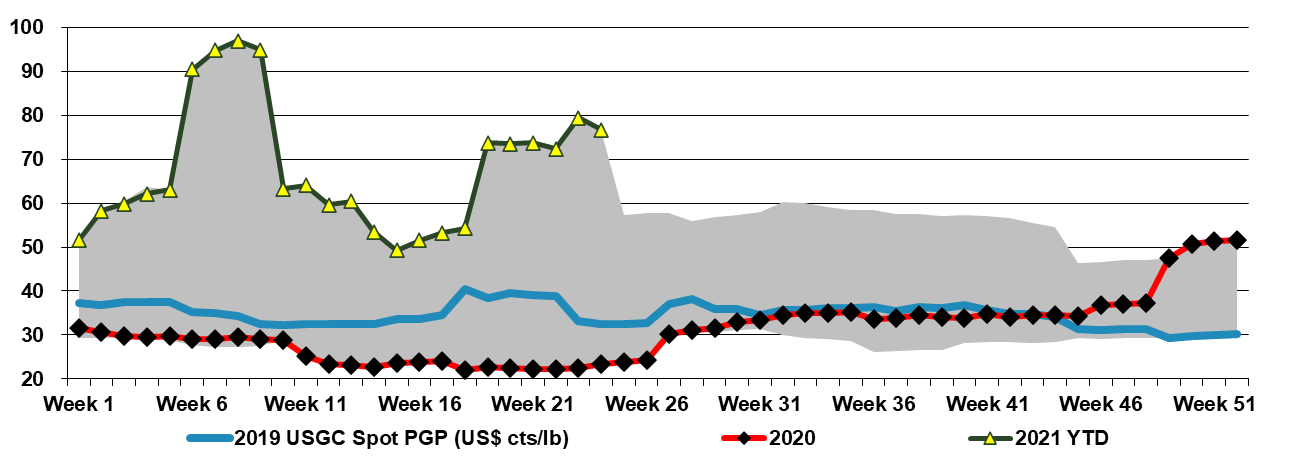Regional PVC price movements are interesting as the World is trying to find balance. Incremental ethylene and chlorine economics in Asia pushed the local spot prices for EDC so low as to shut out US EDC exports – the net result has been more PVC production in the US and a decline in US spot prices. While it is likely that the Asia incremental pricing will improve as some sellers will be losing money and may need to cut back rates, the US will not enjoy a better export market without the acceptance of much lower netbacks, which will maintain negative pressure on domestic prices. That said, PVC is very levered to economic, construction, and housing investment in Asia and there is likely some pent-up COVID-related demand in the region – the oversupplied market may not last for long. We still see a better medium-term outlook for PVC than for other major polymers. There's more detail and coverage on today's daily report linked here.
PVC: Some Signs Of Weakening Near Term, But Still Better Positioned Than Most Peer Polymers Long Term, In Our View
Jul 15, 2021 2:01:06 PM / by Cooley May posted in Chemicals, PVC, Ethylene, PVC price, chlorine, EDC
Propylene: 2H21 Volatility Likely Much More Than The Forward Curve Suggests
Jul 14, 2021 11:29:04 PM / by Cooley May posted in Chemicals, Propylene, Ethylene, polymer grade propylene, PGP
Polymer grade propylene in the US is weakening, albeit slowly, but remains very high versus history, versus ethylene and incremental costs of production. Propylene has the same volatile dynamic that ethylene has today in that if short, consumers can pay a lot more, and if long the price was a long way down to reach any cost hurdle. Just like ethylene we expect the market to show meaningful volatility in 3Q 2021 unless we get a storm effect in the US that impacts production more than demand. The futures market for propane and propylene expects propylene to fall relative to propane and barring weather events this is probably a reasonable view. See more in today's daily report.
US Ethylene: A Slight Imbalance Drives Significant Volatility
Jul 13, 2021 12:52:23 PM / by Cooley May posted in Chemicals, Ethylene, Ethylene Price, US ethylene surplus, Westlake, derivative prices, PVC producer
Spot prices for ethylene have surged in the US in the last week (chart below) – especially for delivery to Louisiana, where Westlake has a production outage. The price increase has completely removed the brief export arbitrage to Asia that lasted for a few weeks in late May and early June (Exhibit 5 in today's daily report). As we discussed on Sunday, ethylene is in a very wide no-mans-land in the US as it is not in sufficient surplus to drive pricing down to costs, and would likely be supported well above US costs and more by Asia costs in the current market, but if the market becomes short, buyers can pay a lot more for it as derivative prices are so high. If a PVC producer, such as Westlake, is buying, they can afford to pay significant premiums given that ethylene is less than 50% of the PVC molecule.
US Ethylene - Spot Market Shows Strength WoW, Likely To Remain Volatile in 2H21
Jul 7, 2021 3:03:39 PM / by Cooley May posted in Chemicals, Polypropylene, Ethylene, propane, Lotte Chemical, US Chemicals, Ethylene Surplus, US ethylene, US ethylene surplus, NGL, LPG cracking capacity
The US ethylene market strengthened slightly in early July, most likely because of supply disruptions as it is hard to see how domestic demand could improve from here. There is not much room to increase prices further if the export market is the balancing mechanism through July and August, as prices remain depressed in Asia and any arbitrage would close quickly if prices in the US moved any higher. Despite the rising NGL prices discussed in today's daily report and on Sunday, the US has plenty of margin left in ethylene, and prices could go lower if that is necessary to move additional volume. While we talk in the opening paragraph about increased inventories of finished goods in anticipation of the year-end holiday season and continued supply constraints, and how this is leading to a shortage of warehouse space, we suspect that everyone upstream of the finished good suppliers is also looking at adding or maintaining a larger inventory cushion than they have in recent years. We still believe that it is a tough call today as to whether you should sell surplus ethylene or store it as we head into hurricane season in the US.
Sell It Or Store It: The Gamble For Ethylene Surpluses In 3Q
Jun 30, 2021 4:10:38 PM / by Cooley May posted in Chemicals, Polyethylene, Ethylene, US ethylene surplus, ethane feed
The higher ethane prices and the sharp increase in 2Q is likely offering some support for ethylene, but the more likely leveling factor of the last week or so has been the Nova outage and any lost production at Westlake, which will have a direct impact on export availability. Until ethylene spot prices in the US approach costs, which are around 10 cents per pound based on ethane feed, the more important driver of pricing will be whether or not there is a surplus and if there is what price is needed to generate export demand. The US ethylene surplus is equivalent to a couple of large plants and consequently, the market can swing from short to long depending on who is operating and is very vulnerable to weather-related closures, although these often take down ethylene derivative plants as well, creating shortages of the derivatives. Polyethylene can afford to pay more than y twice the current price of ethylene, while the ethylene export market needs a further step down from here. Consequently, the range of potential volatility in 3Q is very high – we underestimated the weather impact last year, as did everyone else and it would be a tough call today for a producer with a surplus as to whether to push it into the export market or hold on to it. See more in today's Daily Report.
A Dramatic Change In Fortune For Ethylene
Jun 24, 2021 2:16:00 PM / by Cooley May posted in Chemicals, Ethylene, Ethylene Price, Asia prices, US ethylene
The charts below focus on ethylene and the significant decline in Asia prices, now to levels that suggest negative cash margins. While we may see some cutbacks in production, especially if ethylene from the US can be secured at prices that are even lower than we see in Asia today, most producers will run until they cannot cover variable costs, and given that some of the imbalance, in China especially, might be short term in nature, it is unlikely that we will see any drastic production decisions yet. While the capacity additions in China have been extreme, demand is subdued domestically as consumer spending has not returned to its pre-pandemic trend and the shipping and port problems are hindering export demand.
US Ethylene & Propylene: Very Different Markets!
Jun 23, 2021 3:22:37 PM / by Cooley May posted in Chemicals, Propylene, Polyethylene, Ethylene, Monomer, polymer pricing, Baystar, US ethylene pricing, propane pricing, Ethylene Surplus
The Baystar polyethylene start-up date is consistent with the guidance that the company has been providing for a while, but it still leaves the venture with an ethylene surplus until that time and while the ethylene has been placed, according to the company, the ethylene that it has displaced will likely keep some downward pressure on US ethylene pricing until the polymer plant starts up (all things being equal). Even when the polymer plant starts, the US is expected to have a net ethylene surplus and we would expect exports to continue and prices to reflect levels to make the exports possible.
Butadiene: Strong Global Demand Overwhelmed By New Asia Production
Jun 18, 2021 4:51:58 PM / by Cooley May posted in Chemicals, Ethylene, supply and demand, Chemical Demand, freight, Asia, butadiene derivatives, butadiane
The exhibit below looks at the difference between a strong butadiene market in the US and a much weaker one in Asia. The strength in the US is a function of the stronger US economy and consumer spending as well as logistic issues with products containing butadiene derivatives, but also because there is no incentive to increase heavier cracker feedstock use right now in the US and consequently co-product butadiene supply remains constrained.
Propylene Too Expensive, Ethylene Cheap Enough
Jun 15, 2021 2:18:27 PM / by Cooley May posted in Chemicals, Propylene, Polyethylene, Polypropylene, Ethylene, Auto Industry, polymer pricing, consumer spending
The weakness in polymer pricing in Asia and the drag that auto sales had on US consumer spending in May (spending was up ex-autos) should begin to undermine the very strong polypropylene market in the US, and the fall may happen at a reasonable clip. Polypropylene is more fungible than polyethylene, in that much more of the customization of polypropylene comes post-production rather than during production. There are several unique polyethylene technologies, especially for linear-low where the process drives the properties and adds value. For polypropylene, while there is some of this, most product is compounded and consequently, there is more fungibility before compounding and less risk from experimenting with suppliers. If freight rates were not so high as discussed in today's daily, we believe that we would have seen a notable amount of polypropylene moving from Asia to the US by now.
Ethylene Weaker Again - Is Propylene On The Edge?
Jun 11, 2021 1:19:33 PM / by Cooley May posted in Propylene, Ethylene, Monomer, polymer pricing, polymer grade propylene, PGP, USGC, RPG, refinery grade propylene
USGC ethylene spot prices have weakened since reaching a multi-year peak in mid-April, something we have discussed for some time. This week's downtick in propylene values is a bit more unique as it has occurred alongside weakness in other monomer markets, which is a general trend that appears likely to gain momentum. Most monomer markets are weakening from recent 2Q21 highs in the US. We broadly find an increasing level of support for our view that many commodity chemical product prices will peak for the year in 2Q21. Exhibit 1 in our Daily Report shows an Asia arbitrage that should allow US ethylene to move to Asia, but is in the potential to take it because of local Asia surpluses, Asia prices will remain under pressure, although ethylene values in this region are fast approaching costs. We will soon be back to the previous equilibrium in an oversupplied ethylene market, where the economics of Asia production sets prices, and US exporters make a margin based on their cost advantage. The question now is how long it is before polymer prices follow.




